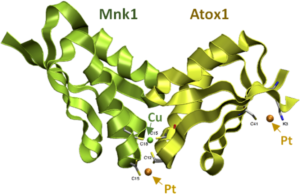The inorganic side of lysosome cell biology: the network of metal-protein interactions
Cu homeostasis is primarily regulated by soluble and membrane transporters that exchange the metal ion between the cytosolic and extracellular compartments, in order to maintain the concentration in a narrow range between essential and toxic levels. Less known is the storage form of Cu and the utilization of mobile pools contained in subcellular compartments. Lysosomes play a significant role in metal homeostasis through the regulation of intercompartmental fluxes of metal ions, their redox state, storage and detoxification as well as through the control of metal-mediated signaling events. Cu homeostasis exemplifies how the correct balance of potentially toxic metals is maintained. In the cytosol, the Cu chaperone ATOX1 interacts with ATP7A and ATP7B, the Menkes and Wilson proteins respectively, in a Cu-dependent manner.
The consequence of ATOX1 inhibition is an increase of intracellular Cu, which produces oxidative stress and cell death [1]. In response to elevated Cu, ATP7B moves from the Golgi to lysosomes and imports metal into their lumen. Moreover, ATP7B enables lysosomes to undergo exocytosis, which operates as an integral process in Cu excretion (Figure 1) [2]. On the other hand, lysosome-related organelles, such as melanosomes and phagosomes, receive ATP7A from the Golgi and utilize it for Cu import [3]. Another protein, the high-affinity Cu transporter CTR1, resides at the cell surface and in endocytic vesicles. CTR1 utilizes a combination of histidine and methionine clusters (HHM motifs), in the N-terminal ectodomain, to accomplish Cu acquisition under different cell and tissue-specific scenarios [4]. In the acidic lysosomal lumen, CTR2 is required to stimulate cleavage of CTR1 ectodomain in order to mobilize endosomal Cu stores and make Cu bioavailable to the cytoplasm [5].
It has been discovered that Cu is trapped in lysosome-related organelles (called cuprosomes) under Zn starvation. When Zn levels return to normal, Cu is released with simultaneous trapping of Zn [6]. The driving force for moving Cu in and out of these traps is not known.
At low Cu concentrations, Zn can bind to CXXC motifs and mediate interactions between ATOX1 and N-terminal metal-binding domains (NMBDs) of Cu-ATPases [7]. Thus, Cu bioavailability may depend on a complex interplay with Zn, involving HHM and CXXC motifs.
Cisplatin accumulates in a variety of vesicular structures, including lysosomes [8;9]. One possibility is that the drug enters from the cytosol via passive diffusion or is pumped by ATP7A and ATP7B. Another possibility is that cisplatin enters lysosomes through the endosomal route [10].
Hydrophobic anticancer drugs are sequestered in lysosomes, inducing TFEB-mediated lysosomal biogenesis, a marked increase of lysosome numbers per cell, and exocytosis [11]. By contrast, other reports indicate that cisplatin-resistant cells have significantly less lysosomes than the sensitive cells [12]. Consequently, ATP7A and ATP7B are mislocalized and cisplatin resistance is paradoxically accompanied by increased rather than decreased whole-cell accumulation [8].
Sequestration of cisplatin into lysosomes can trigger apoptosis, due to lysosome membrane permeabilization (LMP), or affect delivery of cisplatin to the nucleus, where it can attack DNA. Accumulation of metal nanoparticles (NPs) in the endo-lysosomal compartment is the leading cause of nanotoxicity, due to NP degradation and in situ release of metal ions [13]. Cells respond by elevating expression of ATP7A, which can play a role in exporting intracellular Ag [14].
In this project we aim to elucidate, at the atomic-scale, the interaction of Cu transporters with essential and exogenous metals that accumulate in lysosomes, and to correlate these interactions with the observed effects at the cellular level.
We plan to study the ectodomain of CTR1 (containing the versatile and pH sensitive HHM motifs) and the six NMBDs of Cu-ATPases (regulating enzyme activity and trafficking through interaction with ATOX1 and dynactin p62 via CXXC motifs). The structure of soluble regions of membrane transporters remained elusive due to their intrinsic flexibility. A key to solving the structure could be the synergistic effect of Cu and Zn ions. A number of observations indicate a cross-talk between metals that co-localize in lysosomes and target the same binding sites. The energetics of these processes and the metal affinity will be
determined and the processes will be visualized in cultured cells. Moreover, using point and truncation mutants, the role of specific residues and domains will be determined. Finally, chelating molecules able to alter the intracellular metal concentration or protein expression levels will be designed and investigated.
| Acronimo |
|---|
| HYCHEMFLY |
| Bando / Avviso |
| PRIN: PROGETTI DI RICERCA DI RILEVANTE INTERESSE NAZIONALE – Bando 2017 |
| Ente finanziatore |
| MUR |
| Coordinatore scientifico |
| Fabio Arnesano |
| Partner |
| Università di Bari, Università di Catanzaro, Università di Catania, Università di Caserta |
| Data inizio |
| 01/10/2019 |
| Data fine |
| 30/04/2024 |



